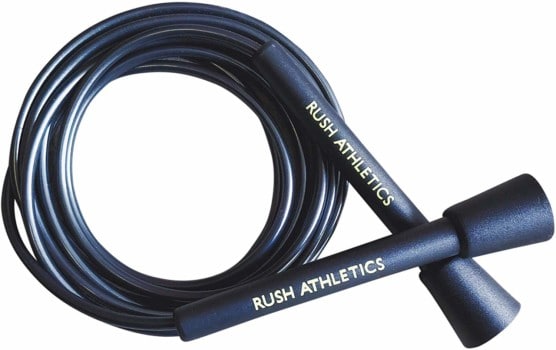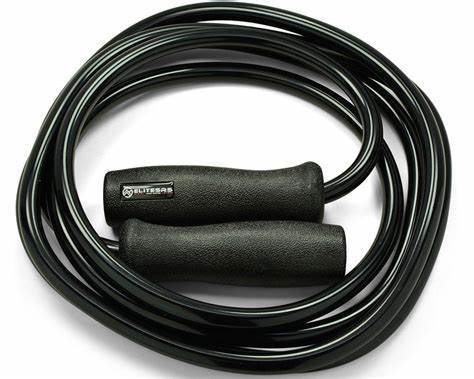There are pros and cons to working out with a weighted jump rope. Most experienced jumpers have both a speed rope and a weighted jump rope, for that reason. That said, if this is your first jump rope, I highly suggest getting a weighted or heavy rope.
My first jump rope was a weighted one. It made learning how to jump rope so much easier. The success it provided me, early on, is likely a big reason why I still jump rope today.
I’ll include the jump rope I started with below (which I still use to this day), along with my favorite speed rope in case you decide to pick up both.
First, let’s cover the pros and cons to using a weighted jump rope.
Benefits of using a weighted jump rope (the Pros)
If you’re new to jumping rope, the best thing you can do is pick up any jump rope (weighted or not) and get started. There are, however, some real benefits to learning with a weighed jump rope. Here are the top 5 benefits of using a weighed jump rope.
1. Easiest rope to learn how to jump rope with
First and foremost, learning how to jump rope with a weighted rope is significantly easier than starting with a speed rope. The additional weight in the rope (or handles) gives you more control over each rotation making it much easier to find your rhythm and pace.
With a heavier rope you can actually feel the rope as it rotates around your body. And, each rotation is much slower which can be extremely helpful for a novice jumper.
A speed rope also requires more wrist movement when spinning the rope. Whereas a heavy rope almost rotates itself, due to the momentum of the rope or cable. This allows you to focus more on your form, which is critical when learning how to jump rope.
Speaking of which, take a look at our How to Jump Rope article for some tips on proper form.
Slowing things down in the beginning, allowing yourself to focus on posture and form, will help later when it comes time to perform more advanced movements like double-unders and crossovers. Good form is key!
There are many kinds of weighted jump ropes out there. It’s important you select the right one if you’re new to jumping rope. I’ve included my favorite heavy rope below, the same one I learned how to jump rope with.
Take a look before you get started!
2. Great shoulder workout
Another thing you will get from a weighted jump rope, that you won’t get from a speed rope, is a killer shoulder workout.
Instead of using your wrists to rotate the rope (like you do with a speed rope), a weighed jump rope requires you to engage your shoulders and back muscles to spin the rope. This makes for an incredible shoulder workout in a fairly short amount of time.
The results are noticeable, too.
Within only a few weeks of jumping with a weighted rope I saw more size and definition in my shoulders. Helping me achieve that coveted tapered-v look is probably my favorite benefit from using a heavy rope.
And not only will it help increase your overall shoulder strength, but it also helps with shoulder endurance. This is a big reason why I started using a weighted rope in the first place.
Coming from a background in kickboxing, shoulder endurance is critical for keeping your hands up and throwing punches. Training with a 1lb or 1/2 lb jump rope provides that added stamina to enable you to go the distance.
Regardless of whether you’re training for sport or for general fitness, training your shoulders should be a key component of your regimen. Pick up a weighted jump rope and give it a shot. Trust me, it’ll make a huge difference!
3. Better calf workout
Another benefit of jumping rope, weighted or not, is its ability to train your calves. And, coming from someone who has genetically smaller calves, that is a huge benefit!
A weighted jump rope, specifically, is a great way to add both definition and endurance to your calf muscles.
One of the first things you’ll notice when you start jumping rope is how taxing it is on your lower leg muscles. For many people, the calves are the first thing to give out when jumping rope as a beginner. The calves are also the one muscle you’ll see the greatest improvement in, initially.
This is another reason why I started jumping rope. I needed to strengthen my legs to become a better kickboxer. And there aren’t too many cardio exercises better at doing that than a heavy jump rope.
Again, it’s important to choose the right weighted jump rope. It’s worth adding to your workouts, though, if you’re looking to increase the size and performance of your calves.
4. Trains your conditioning, coordination, and footwork
The real reason I started jumping rope with a weighted jump rope was because my kickboxing coach required it of me. He had me use a weighted Muay Thai Jump Rope with a heavy plastic rope to train both my conditioning and coordination, and my footwork.
A weighted rope is especially good at this because of how painful it is to smack your feet with the rope. You’ll learn very quickly to jump high enough and time your jumps properly.
While that might sound a little… sadistic, it elevated my jump rope game extremely fast.
In a matter of weeks, I was jumping for 20-30 minutes without tripping over my rope. I was also able to upgrade to a speed rope with literally zero ramp-up or error.
You’ll also find that switching to a speed rope, after a few weeks of working with a heavy rope, is an extremely easy transition. Specifically, your stamina and how long you can go for before getting tired. The weighted rope is one of the best tools for conditioning.
I’d say a weighted jump rope is one of the best tools to train for nearly any sport.
5. More control
The primary skill required to become a great jumper is control. Not just control of your body (your feet, your shoulders, your arms, etc.), but control of the jump rope itself. Without this, it will be incredibly difficult to master any of the more advanced jump rope skills and tricks.
This is where the weighted jump rope excels.
With a weighted jump rope, you have significantly more control over the rope than you would with a speed rope. This is because the rope travels at a fraction of the speed a traditional jump rope does.
By slowing things down, you’re able to focus on the core fundamentals of the movement. Things like keeping your knees slightly bent, your elbows tucked to your side, your wrists pointed outwards, head up, etc.
Learning proper form upfront is key to being successful with some of the more advanced moves you’ll attempt later.
Another benefit from slowing things down and having more control over your jump rope is longevity. One of the most common reasons newer jumpers stop jumping rope is their lack of success, early on.
Slow things down and find some success in the beginning. Those little wins as a beginner will give you the drive to become better with your jump rope as time goes on.
Downsides of using a weighted jump rope (the Cons)
While there are many benefits from using a weighted jump rope, especially as a beginner, there are a few things it doesn’t provide that a speed rope does. This is why if you’re serious about jumping rope, I highly suggest getting yourself both a heavy rope and a speed rope.
Here are 3 cons of using a weighted jump rope.
1. Not meant for freestyle jump rope
Probably the single biggest downside from using a weighted jump rope is the inability to perform more advanced jump rope moves like crossovers and double-unders.
Once you become a more proficient jumper, you’ll likely want to add some of these tricks to your repertoire. This is referred to as “freestyle jump rope”. It’s the flow between various jump rope movements. You’ve likely seen this if you’ve ever watched a Boxer jump rope.
It’s almost like dancing and it can be beautiful when performed correctly.
Not that this can’t be done with a weighted jump rope, it’s just extremely difficult to perform these kinds of movements without a speed rope.
I always knew I wanted to be able to freestyle jump rope. However, it wasn’t until I became proficient with the heavy rope that I was able to move on to a speed rope and learn many of the more complex movements.
My suggestion is to start with a weighted jump rope and master it. Get really good at the basic jump, at the boxer step, some of the more basic movements. Once you find that you can do those with your eyes closed (literally), then pick up a speed rope and try something more complex.
You’ll find, like I did, learning how to freestyle with a speed rope is much easier once you’ve mastered a heavy jump rope. And, this is when things become really fun.
Be patient and learn the ropes (pun intended)… you’ll be glad you did.
2. Trains for endurance, but not speed
Another con to only training with a weighted jump rope is the fact that it primarily trains endurance, not speed. This is why it’s best to have both a weighted rope and a speed rope.
A weighted jump rope is a great tool for building your conditioning and stamina. You’ll find that after working with a heavy jump rope, for even just a few weeks, you’ll be able to jump for much longer. That conditioning will especially be apparent when switching from a heavy rope to a speed rope.
Because of the additional weight, though, trying to perform quicker movements like double-unders and crossovers is difficult with a heavier rope. Regardless of if the weight is in the handles or the cable, these kinds of movements are best done with a lighter rope.
It does depend, a bit, on how heavy the rope is. Certain weighted jump ropes are only a 1/2lb or less. With these ropes you might be able to get away with training for speed.
That said, when it comes to training for speed your best bet is a speed rope.
A speed rope is going to have lighter handles and will typically have a steel cable or PVC cord. These materials will rotate much quicker allowing you to perform some of those faster movements.
3. It can become monotonous (boring)
The last major con I can think of, when it comes to using a weighted jump rope, is after a while it can become fairly monotonous.
The last thing I want to do is deter you from trying out a weighted jump rope. There are some really tremendous benefits from incorporating it into your regimen. But, given it limits you to only a handful of jump rope movements, it can become a bit boring.
The heavy jump rope only allows you to perform some of the more basic jumps, like the boxer step, scissor step, etc. While these are important to learn, the more enjoyable tricks are done with a speed rope.
So, there is definitely a time and place for the weighted rope, but to truly get the most out of your jump rope routines you’ll need to make the switch to a speed rope at some point.
Your best bet is to start with a weighted jump rope, master that, then move on.
I’ve included my favorite speed rope below. I’ll usually alternate between the weighted rope and speed rope during the week, which provides some variety to my workouts.
The best weighted jump rope in 2021
If you’re considering picking up a weighted jump rope, it’s important to pick the right one. There are some poor designs out there. There are also some weighted ropes that have specific applications, not relevant to what we’re looking to do.
I’m going to make it easy for you, though. I’ve been using the same weighted skipping rope since I learned how to jump rope. It’s well-made and isn’t too heavy.
Your best bet is to pick up the Muay Thai Jump Rope by EliteSRS.
This jump rope is made from a thick plastic and weighs about 1.3lbs. It has thick plastic handles and uses dual ball-bearings to rotate the cord. I never have an issue with it getting tangled…
The rope comes in 3 different sizes (8ft, 9ft, and 10ft). Which is perfect for me and I’m 6’ 2”.
The great thing about this jump rope is it’s not only made well, but it’s also extremely affordable. I’m not sure what the current price is, but it’s usually only about $30. I’ve included a link above to my Recommended Product Page where you can see how much it’s selling for.
If you decide to go with a different rope, I’d keep a couple things in mind.
Avoid any ropes that are made from cloth or actual rope. These can be very difficult to learn with, let alone use as an experienced jumper. Additionally, I’d only consider ropes that use ball-bearings as most other designs can tangle easily.
I’m confident you’ll find something that works well!
The best speed rope in 2021

If you decide you’d like to pick up both a weighted skipping rope and a speed rope, look no further than the Speed Rope by Rush Athletics, also known as the “Money Rope”.
I’ve used a variety of different speed ropes over the years. This is by far the best value.
The thing I love about this rope the most is how easy it is to adjust the length. You can make it shorter or longer in a matter of seconds. It’s also made incredibly well, making it one of the more durable ropes for the price.
The rope is made from vinyl, PVC cord and is about 5mm thick. It’s perfect for performing double-unders and crossovers. The handles are also a bit longer and made from a lightweight plastic, which makes this rope perfect for freestyle jump rope.
You really can’t go wrong with this guy…
If you do decide to go with a different rope, I’d tend to opt for a rope that uses slightly longer handles which make it easier to control. Also, go with a rope made from either PVC or a wire cable, these will allow for the most speed.
Stay away from leather ropes, they are terrible.
I’ve included a link to my Recommended Product Page where you can see how much this jump rope is going for, currently. Like the Muay Thai Jump Rope from EliteSRS, it’s super affordable.
Best of luck, reach out if you have any questions!

